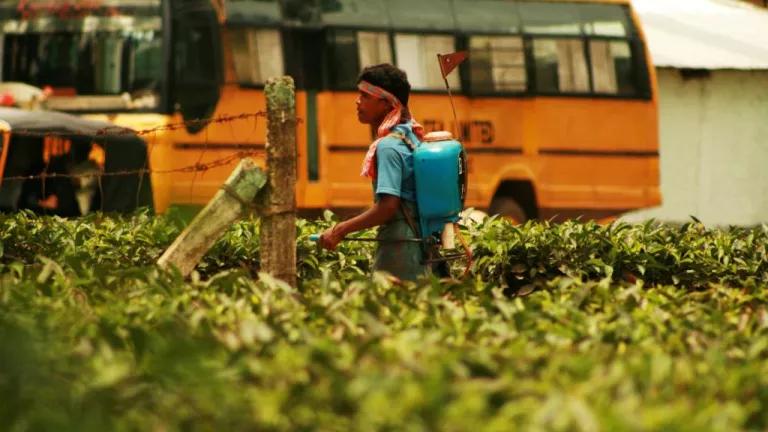
This last week in August has always been my favorite time of year: the seasons are just starting to change but the weather is still warm and pleasant, gardens are flourishing, and as a child back to school meant back to friends, new crayons and a new soccer season. However, for thousands of children in California, back to school includes the risks of exposure to toxic chemical pesticides that are bad for their developing brains and nervous systems.
California's agriculture landscape is unlike the rest of the country; the Golden State produces nearly half of US-grown fruits, nuts, and vegetables. In California's Central Valley, communities are interspersed among and adjacent to fields of the more than 400 commodities grown here. That means local families come in close contact with pesticides that are sprayed on fields for maximum yields and to keep food looking pristine. However, often times, pesticides don't stay within the borders of the fields; chemical residues can drift and settle in nearby schools, playgrounds, porches, laundry lines, and residents' bodies.
Children are especially vulnerable to the risks of pesticide exposure: they eat, drink and breathe more for their bodyweight than adults do; their bodies are still developing and maturing so that exposures now can cause permanent disruptions; they experience the world in a hands-on way that includes hand-to-mouth accidental ingestion. And yet, across California, large numbers of the most toxic pesticides are applied to fields located near schools.
Chlorpyrifos (trade name Dursban), is one of those pesticides used in alarming proximity to schools. It is used on a whole host of crops including almonds - one of the top valued commodities in the state - along with walnuts, citrus, alfalfa, grapes, and broccoli. Chlorpyrifos, a member of the organophosphate family of pesticides, was developed from a World War II era nerve gas that causes nausea, confusion, and breathing difficulties when people are exposed at low levels, and is particularly toxic to the developing nervous system and brain functioning of young kids and fetuses. There is no reason why kids should be exposed to toxic chemicals like chlorpyrifos while at school.
California's Department of Pesticide Regulation (DPR) has begun to draft proposed regulations to better protect the health of schoolchildren from exposure to hazardous pesticides used near public schools; it is essential that DPR adopt strong, healthy protective regulations and conduct studies to evaluate the ongoing risks to children posed by pesticides sprayed near schools. Along with coalition partners, NRDC has called for discrete actions by the agency that will provide better protection and evaluate further risks to children posed by pesticides used near schools.
- Communities have a right to know in advance about pesticide applications within a mile of schools. Schools should be notified and communicate this information to teachers and parents prior to pesticide applications. However, notification alone does not mitigate the risks associated with the application of hazardous pesticides near sensitive sites and DPR must adopt policies that actually limit exposures.
- Buffer zones can decrease the likelihood that bystanders will be exposed to pesticide drift. However, because there are still numerous incidents of illness resulting from pesticide drift from nearby farmlands, even when pesticides are applied following current label directions, current buffer distances on labels are inadequate and should be expanded. Imperial County already requires buffer zones of 1 mile between sensitive sites - like schools and day cares - and where restricted use pesticides - like chlorpyrifos - can be aerially applied. DPR should set the buffer zone around sensitive sites to at least 1 mile unless a comprehensive evaluation suggests that the zone of impact is smaller, or larger.
- Some application methods, like aerial spraying, increase the risk of pesticide drift and exposure; these should be restricted around schools and other sensitive sites.
- DPR should conduct air and dust monitoring to quantify the impacts of pesticide spray drift at schools and day care centers. Monitoring of potential contaminants should be conducted at sites determined to be the most vulnerable to pesticides based on proximity to the application of priority pesticides and a comprehensive, air-shed approach that takes into account weather patterns.
- We agree with a report by the California Department of Public Health from April 2014 on Agricultural Pesticide Use near Public Schools in California, which recommended, "Routine and standardized collection, digitization, and reporting of data on agricultural field locations of each pesticide use permit, which could then be made publicly accessible via the PUR system in a format convenient for Geographic Information Systems."
Ultimately, these actions can only help to mitigate pesticide risks. The most effective way to protect kids from pesticides is to stop using the most toxic chemicals, and any pesticides that are prone to drifting away from the targeted fields. California's Department of Pesticide Regulation must take swift and meaningful action by removing the most dangerous pesticides - like fumigants and organophosphates starting with chlorpyrifos - from the market, reducing rural kids' exposure to these harmful chemicals, and reducing their reach as residue on our food. Please join your voice to our concern that these pesticides remain unchecked: sign a petition like this one to California Governor Brown: http://www.panna.org/issues/related-actions/gov-brown-phase-out-brain-harming-chlorpyrifos, educate others who would share our concern, buy organic produce or at your farmers' market ask your citrus-growers and nuts salesmen if they use organophosphates like chlorpyrifos on their fields.




